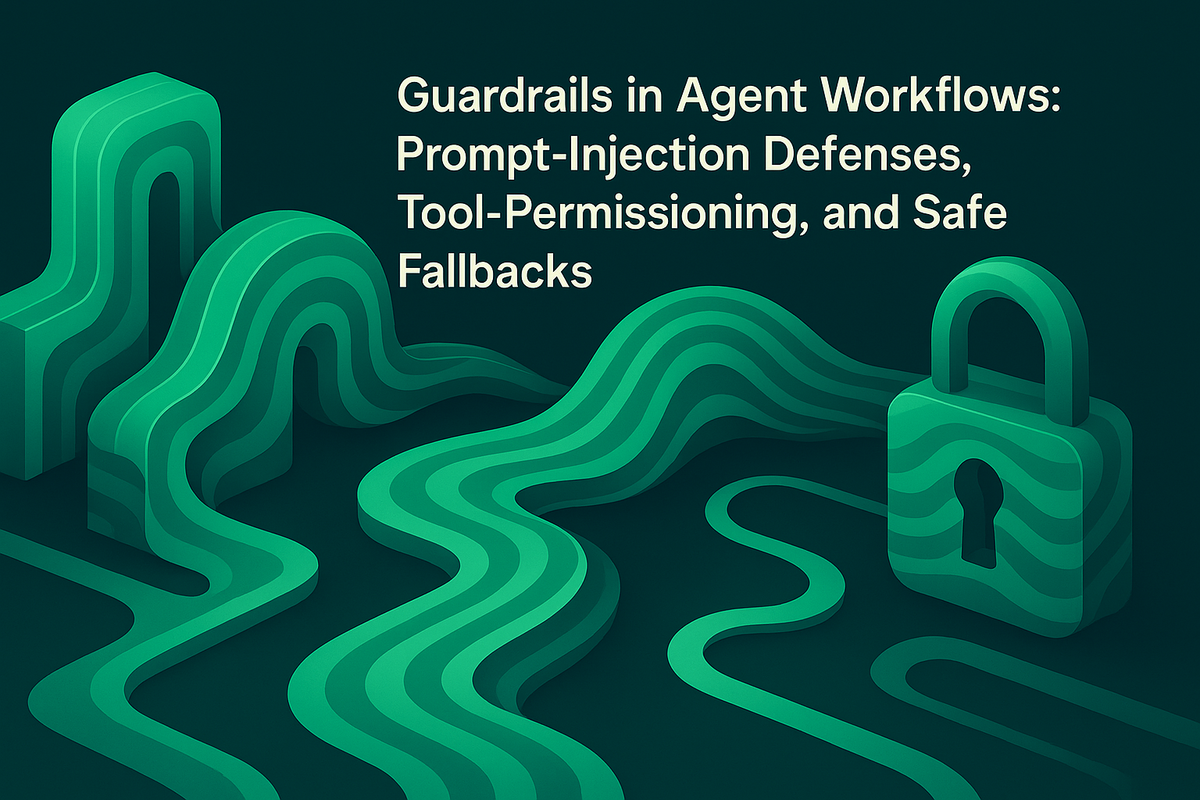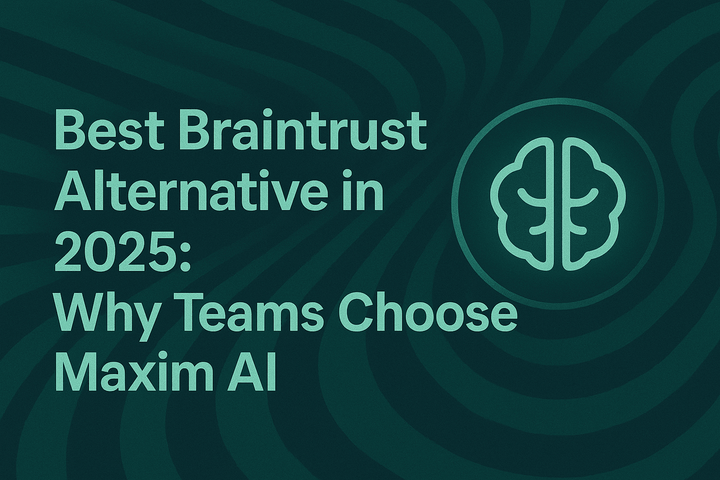Guardrails in Agent Workflows: Prompt-Injection Defenses, Tool-Permissioning, and Safe Fallbacks

TL;DR
Agent workflows require robust security mechanisms to ensure reliable operations. This article examines three critical guardrail categories: prompt-injection defenses that protect against malicious input manipulation, tool-permissioning systems that control agent actions, and safe fallback mechanisms that maintain service continuity. Organizations implementing these guardrails with comprehensive evaluation and observability platforms can reduce security incidents while maintaining agent autonomy and performance.
Understanding Security Risks in Agent Workflows
AI agents operate with increasing autonomy, making decisions and executing actions across complex workflows. This autonomy introduces security vulnerabilities that traditional software security measures don't adequately address. According to OWASP's LLM Top 10, prompt injection ranks as one of the most critical security risks facing AI systems today.
Agentic systems face three primary categories of risks:
- Input manipulation: Attackers craft inputs designed to override system instructions or extract sensitive information. These attacks exploit the language model's instruction-following behavior to bypass intended constraints.
- Unauthorized actions: Without proper permissioning, agents may execute operations beyond their intended scope. This includes accessing restricted data sources, making unauthorized API calls, or modifying system configurations.
- Reliability failures: When agents encounter unexpected scenarios or errors, inadequate fallback mechanisms can lead to cascading failures. Research from Stanford's AI Safety Center highlights that poorly designed error handling in production AI systems contributes to 40% of agent-related incidents.
Implementing effective guardrails requires understanding these risks within the context of your specific agent architecture and operational requirements.
Prompt-Injection Defenses: Protecting Against Malicious Input
Prompt injection attacks manipulate language model behavior by embedding malicious instructions within user inputs. These attacks range from simple instruction overrides to sophisticated multi-stage exploits that extract training data or system prompts.
Input Validation and Sanitization
The first defense layer involves rigorous input validation. Implement content filtering that detects and blocks common injection patterns before they reach your language model. This includes:
- Pattern matching for instruction-like phrases ("ignore previous instructions", "system:", "admin mode")
- Character sequence analysis to identify encoding attacks and Unicode manipulation
- Input length restrictions that prevent context window overflow attacks
Anthropic's research on constitutional AI demonstrates that combining rule-based filtering with learned classifiers significantly reduces successful injection attempts. Organizations should implement multi-layered validation that evolves with emerging attack patterns.
Instruction Hierarchy and Separation
Establish clear boundaries between system instructions and user content. Use structured prompting techniques that explicitly separate trusted system directives from untrusted user inputs:
- Implement role-based prompt sections with distinct markers
- Use XML tags or structured formats to delineate instruction boundaries
- Apply output parsing that validates responses against expected schemas
Maxim's prompt management system enables teams to version and test prompt structures with built-in injection resistance. The platform's prompt playground allows developers to experiment with different separation strategies and evaluate their effectiveness against known attack vectors.
Adversarial Testing and Continuous Monitoring
Defense effectiveness requires ongoing validation through adversarial testing. Implement systematic testing protocols that simulate injection attempts:
- Create test datasets containing known injection patterns
- Generate synthetic attacks using red-team LLMs
- Monitor production inputs for emerging attack signatures
Maxim's evaluation framework supports automated testing against injection vulnerabilities. Teams can leverage pre-built evaluators like toxicity detection and PII detection alongside custom evaluators tailored to specific security requirements.
Production monitoring through agent observability provides real-time detection of suspicious patterns. Configure automated evaluations on logs to flag potential injection attempts and trigger alerts through integrated notification systems.
Tool-Permissioning: Controlling Agent Actions
Tool permissioning establishes which operations an agent can execute and under what conditions. Without proper controls, agents may access sensitive systems, modify critical data, or exhaust resources through unconstrained API calls.
Principle of Least Privilege
Grant agents only the minimum permissions required for their intended functionality. Implement granular access controls that restrict both tool availability and operational scope:
- Define explicit tool allowlists for each agent role
- Implement parameter constraints that limit operation scope
- Use context-dependent permissions that adapt based on workflow state
Research from Microsoft's Responsible AI team demonstrates that fine-grained permissioning reduces security incidents by 60% while maintaining operational flexibility.
Dynamic Permission Management
Static permission models prove insufficient for complex agent workflows. Implement dynamic permissioning that evaluates access requests in context:
- Real-time risk assessment based on requested operation and current state
- Budget controls that limit resource consumption per operation
- Temporal restrictions that prevent operations outside approved time windows
Bifrost, Maxim's AI gateway, provides built-in governance capabilities including usage tracking, rate limiting, and hierarchical budget management. Organizations can define permission policies at team, project, and user levels with automatic enforcement across all model providers.
Tool Call Validation and Logging
Every tool invocation requires validation and comprehensive logging. Implement checks that verify:
- Tool selection appropriateness for current context
- Parameter correctness and safety
- Output validation against expected schemas
Maxim's tool call tracking captures complete execution traces including inputs, outputs, and decision rationale. The tool selection evaluator measures whether agents choose appropriate tools for given tasks, while tool call accuracy metrics quantify parameter correctness.
Configure trace-level evaluations to assess tool usage patterns and identify permission violations before they impact production systems.
Safe Fallbacks: Ensuring Reliability Under Failure
Even well-designed agents encounter scenarios requiring fallback mechanisms. Safe fallbacks maintain service continuity while preventing cascading failures or undefined behavior.
Hierarchical Fallback Strategies
Implement multi-tiered fallback approaches that gracefully degrade functionality:
Model-level fallbacks: When primary models fail or timeout, route requests to alternative providers. Bifrost's automatic fallback system enables seamless failover between providers with zero downtime, supporting intelligent load balancing across OpenAI, Anthropic, AWS Bedrock, Google Vertex, and other major providers.
Workflow-level fallbacks: Design agent workflows with explicit fallback paths for common failure scenarios. Use decision trees that route to simpler, more reliable operations when complex processes fail.
Human-in-the-loop escalation: For critical operations, implement escalation to human oversight when confidence thresholds aren't met. Define clear handoff protocols that preserve context and enable efficient resolution.
Error Detection and Recovery
Effective fallbacks require robust error detection mechanisms. Implement monitoring that identifies:
- Model output quality degradation
- Unexpected tool call patterns
- Response latency anomalies
- Context window exhaustion
Maxim's agent trajectory evaluator analyzes complete execution paths to identify suboptimal decision sequences. The task success metric measures whether agents complete intended goals, while step utility analysis evaluates individual action effectiveness.
Distributed tracing through Maxim's observability platform provides complete visibility into execution flows. Teams can identify failure patterns, reproduce issues through simulation reruns, and validate fixes before deployment.
Caching and Performance Optimization
Fallback mechanisms must not introduce unacceptable latency. Implement intelligent caching strategies that maintain performance during degraded operation:
Semantic caching: Bifrost's semantic caching uses embedding-based similarity matching to serve cached responses for semantically equivalent queries. This reduces costs and latency while maintaining response quality during provider outages.
Response prefetching: For predictable workflows, precompute and cache responses for common scenarios. This enables instantaneous fallback to cached results when real-time generation fails.
Graduated timeout strategies: Implement progressive timeout increases that balance responsiveness against completion probability. Start with aggressive timeouts for fast paths, falling back to more generous limits for complex operations.
Implementing Guardrails with Maxim AI
Deploying comprehensive guardrails requires coordinated implementation across experimentation, evaluation, and production monitoring. Maxim provides an integrated platform that supports guardrail development throughout the AI lifecycle.
Pre-Production Validation
Use Maxim's experimentation platform to develop and test guardrail mechanisms before production deployment. The prompt playground enables rapid iteration on input validation strategies and instruction separation techniques.
Create comprehensive test suites using dataset management tools that include adversarial examples and edge cases. Configure batch evaluations that assess guardrail effectiveness across multiple dimensions.
Agent simulation validates fallback behavior under realistic failure scenarios. Generate synthetic interactions that stress-test permission boundaries and recovery mechanisms, measuring quality using specialized evaluators like context precision and faithfulness.
Production Monitoring and Improvement
Deploy agents with comprehensive observability using Maxim's tracing capabilities. Instrument workflows to capture complete execution context including tool calls, model interactions, and decision rationale.
Configure automated quality checks that continuously assess production performance. Set up alerts for guardrail violations, anomalous tool usage, and fallback activation patterns.
Collect user feedback and combine with human annotation to continuously improve guardrail effectiveness. Use data curation workflows to evolve test datasets based on production observations.
Integration with Bifrost Gateway
Deploy guardrails at the infrastructure level using Bifrost as your AI gateway. Bifrost's unified interface simplifies provider management while enforcing consistent security policies across all model interactions.
Implement custom plugins for organization-specific guardrail logic. Configure budget management to prevent resource exhaustion and enable SSO integration for centralized access control.
Leverage Model Context Protocol support to safely enable tool usage with fine-grained permission controls. Bifrost's observability features provide native Prometheus metrics and distributed tracing that integrate seamlessly with Maxim's evaluation platform.
Conclusion
Effective guardrails represent the foundation of reliable agent deployment. Organizations implementing comprehensive prompt-injection defenses, tool-permissioning systems, and safe fallback mechanisms can confidently scale agent operations while maintaining security and reliability.
Success requires integrated tooling that supports guardrail development across the entire AI lifecycle. Maxim's platform provides the experimentation, evaluation, and observability capabilities teams need to build, test, and monitor robust guardrail implementations.
Production-ready guardrails demand continuous validation and improvement. Regular adversarial testing, comprehensive monitoring, and data-driven refinement ensure guardrail effectiveness evolves with emerging threats and operational requirements.
Ready to implement robust guardrails for your agent workflows? Schedule a demo to see how Maxim accelerates secure agent development, or sign up to start building with comprehensive evaluation and observability tools today.


